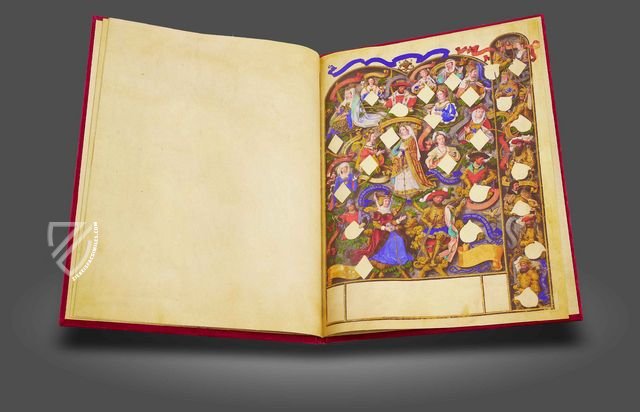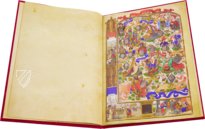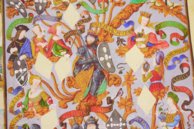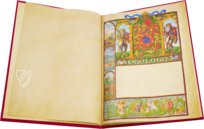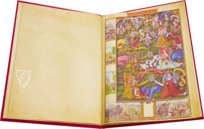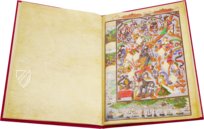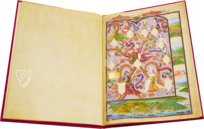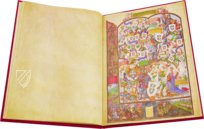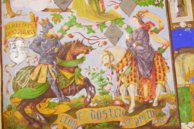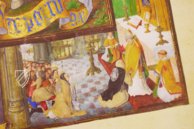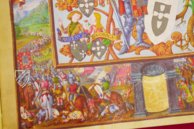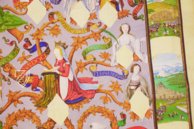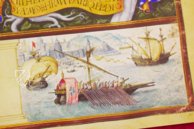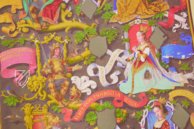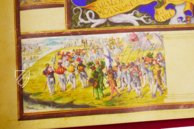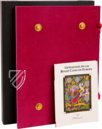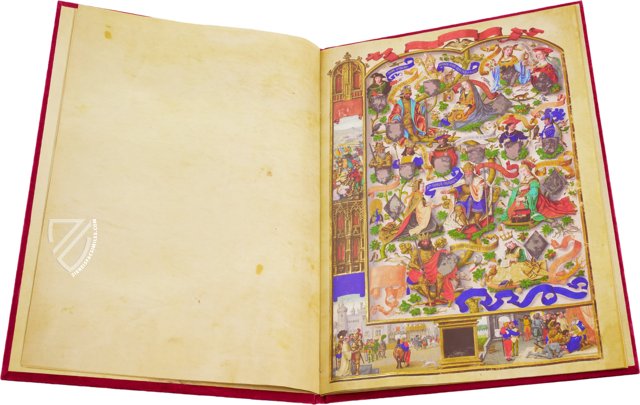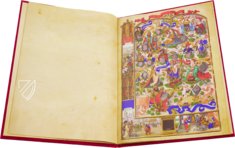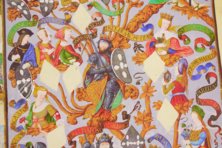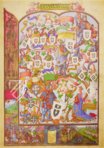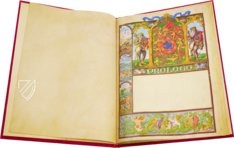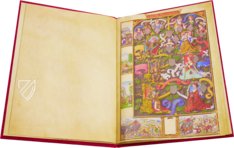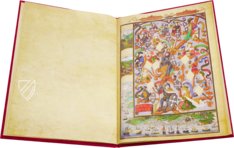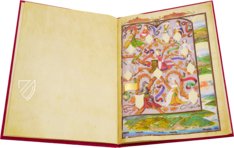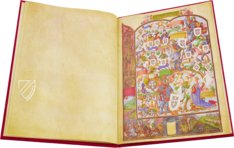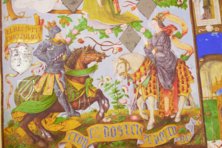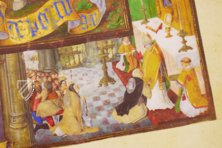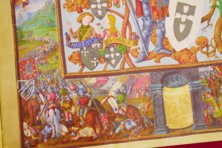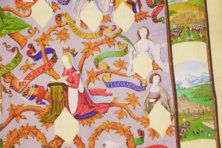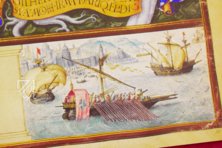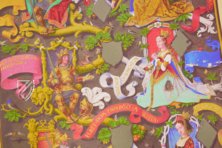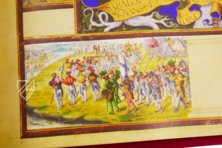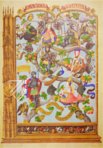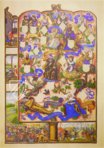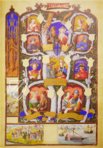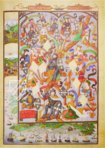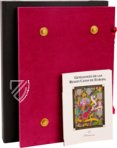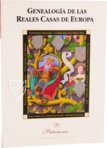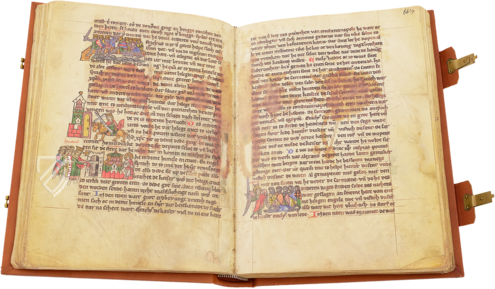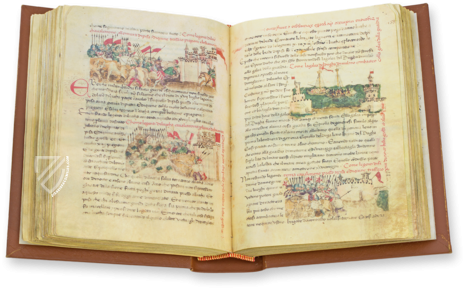Portuguese Genealogy
(3,000€ - 7,000€)
This beautiful genealogy originated from a collaboration between two of Europe’s best illuminators. The Portuguese diplomat Damião de Góis (1502–1574) reports that Ferdinand of Portugal (1507–1534) commissioned the genealogical tree of the lines of Noah up to his famous father King Manuel I. Between the years **1530 and 1534, the Belgian Simon Bening (1483–1561) and the Portuguese Antonio de Hollanda (1490–1571) worked together on the 26-page parchment manuscript. Those who behold it are fascinated by its 13 full-page miniatures and 29 marginal depictions, especially the grandiose marginal depictions of mythological figures and battle scenes. The princely figures are represented with an unbelievable attention to detail and are surrounded by inventive scenes with picturesque landscapes and splendid architectures.
Portuguese Genealogy
Two of the most important illuminators of the 16th century collaborated on the Genealogy of the Royal Houses of Europe. Simon Bening (1483–1561) and Antonio de Hollanda (1490–1571) worked on the splendid genealogy between 1530 and 1534. It presents 13 full-page miniatures with partially historiated bordures and 29 marginal depictions on 26 parchment pages. According to the diplomat Damião de Góis (1502–1574), this collaboration between Lisbon and Bruges was probably commission by Ferdinand of Portugal (1507–1534) and was conceived of as a genealogy stretching from Noah to his father King Manuel I.
The Best Illuminators in Europe
Ferdinand of Portugal employed Europe’s two best illuminators: Simon Bening and Antonio de Hollanda. Bening was a Flemish painter from Bruges who in his youth had already been an assistant in the workshop of his father Alexander Bening and founded his own ca. 1500. He completed five sheets for the family tree. According to the records of his son Francesco in his copy of Vasari, the Portugal-based Antonio de Hollanda was responsible for the design and painting of seven pages. An unpainted page shows Hollanda’s masterful drawing with fine details.
A Family Tree of a Specific Nature
The genealogy by Bening and Hollanda is something very special. The multifaceted portraits find themselves amidst lovely boughs and range from busts to full body pictures and the names of the depicted are indicated by artfully curved banderoles. In doing so, they find themselves in a wide range of positions and are never rigid. Furthermore, their clothing exhibits gorgeous details: the elaborate headdresses of the women shine in luminous colors and their costly garment are endowed with charming trim. With the men, it is the shimmering suits of armor that catch of the eye of the beholder with their opulence. These princely figures are attended by numerous small birds flying between and around the branches. There are also large animals like lions, dogs, and deer to be found in the fanciful miniatures.
Artistic Marginal Décor
The marginal decorations of the miniatures are second to none with their interesting interior spaces and artful landscapes. From dynamic battle scenes with vivid representations of horses, to brilliant church interiors, to broad landscapes with heavenly coursing rivers, it can all be found here. Maritime scenes with enormous ships ** in the foreground and **glorious cityscapes with many small towers in the background are particularly expressive.
Codicology
- Alternative Titles
- Genealogía de las Reales Casas de Europa
Genealogie der Europäischen Königshäuser und Kaiser des Heiligen Römischen Reiches Deutscher Nation
Genealogy of the Royal Houses of Spain and Portugal
Genealogy of the Royal Houses of Europe - Size / Format
- 26 pages / 58.0 × 43.0 cm
- Origin
- Belgium
- Date
- 1530–1534
- Epochs
- Style
- Language
- Illustrations
- 13 full-page miniatures and 29 mariginal miniatures
- Patron
- Damião de Góis
- Artist / School
- Simon Bening
Antonio de Hollanda
Portuguese Genealogy
Pelagius of Asturias
Pelagius was a Visigoth nobleman who established the Kingdom of Asturias in 718, making him the forefather of all future Iberian monarchies. He is also credited with starting the Reconquista, the Christian reconquest of the Iberian Peninsula from the Moors. The children of he and his wife, Gaudiosa, are pictured above: Favila, the successor to the throne who was killed in a hunting accident, and his sister Ermesinda, who then became queen consort to King Alfonso I, pictured in profile.
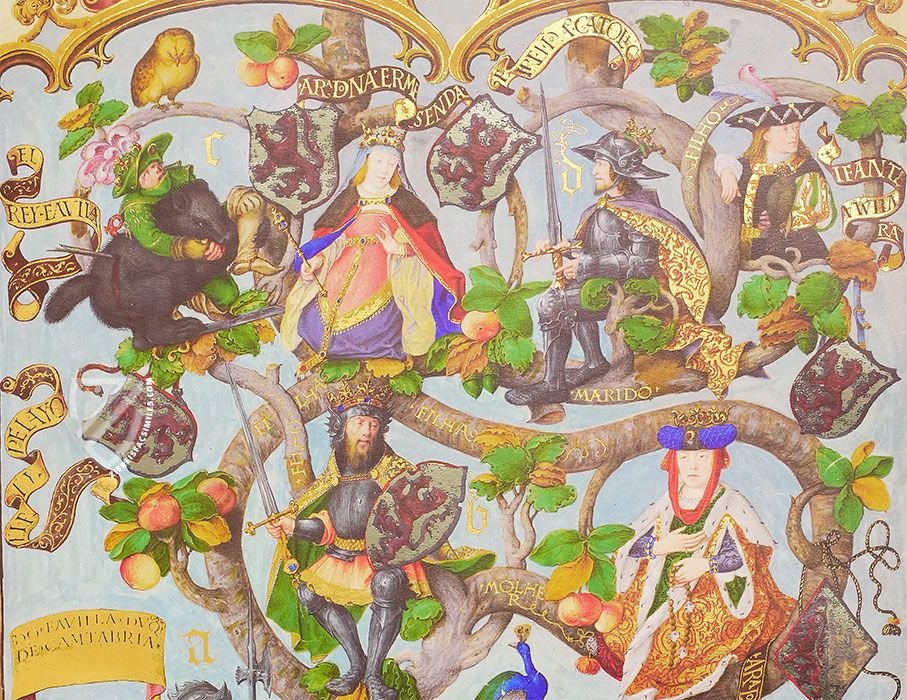
Portuguese Genealogy
The First Three Kings of Portugal
This family tree depicts Portugal’s rulers from Count Afonso Henriques, who became the first King of Portugal in 1139 as Afonso I, to his son Sancho I, and his grandson Afonso II, who ruled until 1223. The first two kings are armored as warriors, the third is more courtly in dress. Their queens are seated in the bows of the tree alongside them with all figures identified by banderoles.
Lisbon’s port is shown in the lower margin with sailing ships detailed in the foreground. The upper miniature on the left depicts a battle against a Christian army, perhaps Castile. Below, we see the Battle of Ourique, Count Afonso’s great victory over the Moors that resulted in the establishment of the Kingdom of Portugal, before which he is depicted having a vision.
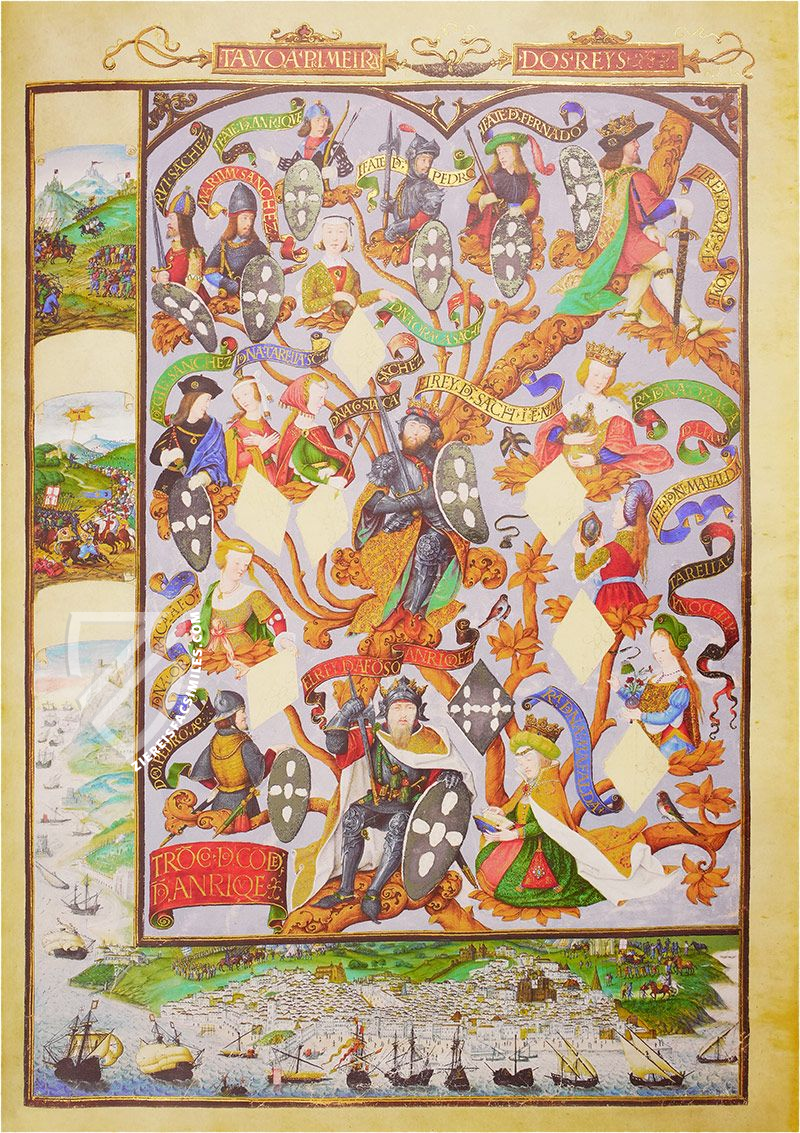
#1 Genealogía de las Reales Casas de Europa Portuguese Genealogy
Language: Spanish
(3,000€ - 7,000€)
- Treatises / Secular Books
- Apocalypses / Beatus
- Astronomy / Astrology
- Bestiaries
- Bibles / Gospels
- Chronicles / History / Law
- Geography / Maps
- Saints' Lives
- Islam / Oriental
- Judaism / Hebrew
- Single Leaf Collections
- Leonardo da Vinci
- Literature / Poetry
- Liturgical Manuscripts
- Medicine / Botany / Alchemy
- Music
- Mythology / Prophecies
- Psalters
- Other Religious Books
- Games / Hunting
- Private Devotion Books
- Other Genres
- Afghanistan
- Armenia
- Austria
- Belgium
- Colombia
- Croatia
- Czech Republic
- Denmark
- Egypt
- Ethiopia
- France
- Germany
- Hungary
- India
- Iran
- Iraq
- Israel
- Italy
- Japan
- Luxembourg
- Mexico
- Morocco
- Netherlands
- Peru
- Poland
- Portugal
- Russia
- Serbia
- Spain
- Sri Lanka
- Sweden
- Switzerland
- Syria
- Turkey
- Ukraine
- United Kingdom
- United States
- Uzbekistan
- Aboca Museum
- Ajuntament de Valencia
- Akademie Verlag
- Akademische Druck- u. Verlagsanstalt (ADEVA)
- Aldo Ausilio Editore - Bottega d’Erasmo
- Alecto Historical Editions
- Alkuin Verlag
- Almqvist & Wiksell
- Amilcare Pizzi
- Andreas & Andreas Verlagsbuchhandlung
- Archa 90
- Archiv Verlag
- Archivi Edizioni
- Arnold Verlag
- ARS
- Ars Magna
- ArtCodex
- AyN Ediciones
- Azimuth Editions
- Badenia Verlag
- Bärenreiter-Verlag
- Belser Verlag
- Belser Verlag / WK Wertkontor
- Benziger Verlag
- Bernardinum Wydawnictwo
- BiblioGemma
- Biblioteca Apostolica Vaticana (Vaticanstadt, Vaticanstadt)
- Bibliotheca Palatina Faksimile Verlag
- Bibliotheca Rara
- Boydell & Brewer
- Bramante Edizioni
- Brepols Publishers
- British Library
- C. Weckesser
- Caixa Catalunya
- Canesi
- CAPSA, Ars Scriptoria
- Caratzas Brothers, Publishers
- Carus Verlag
- Circulo Cientifico
- Club Bibliófilo Versol
- Club du Livre
- CM Editores
- Collegium Graphicum
- Collezione Apocrifa Da Vinci
- Comissão Nacional para as Comemorações dos Descobrimentos Portugueses
- Coron Verlag
- Corvina
- CTHS
- D. S. Brewer
- De Agostini/UTET
- De Schutter
- Deuschle & Stemmle
- Deutscher Verlag für Kunstwissenschaft
- DIAMM
- Droz
- E. Schreiber Graphische Kunstanstalten
- Ediciones Boreal
- Ediciones Grial
- Ediclube
- Edições Inapa
- Edilan
- Editalia
- Edition Georg Popp
- Edition Leipzig
- Edition Libri Illustri
- Editiones Reales Sitios S. L.
- Éditions de l'Oiseau Lyre
- Editions Medicina Rara
- Editorial Casariego
- Editorial Mintzoa
- Editrice Antenore
- Editrice Velar
- Edizioni Edison
- Egeria, S.L.
- Eikon Editores
- Electa
- Enciclopèdia Catalana
- Eos-Verlag
- Ephesus Publishing
- Eugrammia Press
- Extraordinary Editions
- Fackelverlag
- Facsimila Art & Edition
- Facsimile Editions Ltd.
- Facsimilia Art & Edition Ebert KG
- Faksimile Verlag
- Feuermann Verlag
- Folger Shakespeare Library
- Franco Cosimo Panini Editore
- Friedrich Wittig Verlag
- Fundación Hullera Vasco-Leonesa
- G. Braziller
- Gabriele Mazzotta Editore
- Gebr. Mann Verlag
- Gesellschaft für graphische Industrie
- Getty Research Institute
- Giovanni Domenico de Rossi
- Giunti Editore
- Graffiti
- Grafica European Center of Fine Arts
- Guido Pressler
- Guillermo Blazquez
- H. N. Abrams
- Harrassowitz
- Helikon
- Hendrickson Publishers
- Henning Oppermann
- Herder Verlag
- Hes & De Graaf Publishers
- Hoepli
- Hortus Deliciarum
- Houghton Library
- Hugo Schmidt Verlag
- Idion Verlag
- Il Bulino, edizioni d'arte
- ILte
- Imago
- Insel Verlag
- Instituto de Estudios Altoaragoneses
- Instituto Nacional de Antropología e Historia
- Istituto dell'Enciclopedia Italiana - Treccani
- Istituto Ellenico di Studi Bizantini e Postbizantini
- Istituto Geografico De Agostini
- Istituto Poligrafico e Zecca dello Stato
- Italarte Art Establishments
- J. Thorbecke
- Jan Thorbecke Verlag
- Johnson Reprint Corporation
- Jugoslavija
- Karl W. Hiersemann
- Kasper Straube
- Kaydeda Ediciones
- Konrad Kölbl Verlag
- Kurt Wolff Verlag
- La Liberia dello Stato
- La Linea Editrice
- La Meta Editore
- Lambert Schneider
- Landeskreditbank Baden-Württemberg
- Leo S. Olschki
- Les Incunables
- Library of Congress
- Libreria Musicale Italiana
- Lichtdruck
- Lito Immagine Editore
- Lumen Artis
- Lund Humphries
- M. Moleiro Editor
- Maison des Sciences de l'homme et de la société de Poitiers
- Manuscriptum
- Maruzen-Yushodo Co. Ltd.
- MASA
- McGraw-Hill
- Militos
- Millennium Liber
- Müller & Schindler
- National Library of Wales
- Neri Pozza
- Nova Charta
- Oceanum Verlag
- Odeon
- Orbis Mediaevalis
- Orbis Pictus
- Österreichische Staatsdruckerei
- Oxford University Press
- Pageant Books
- Parzellers Buchverlag
- Patrimonio Ediciones
- Pattloch Verlag
- PIAF
- Pieper Verlag
- Plon-Nourrit et cie
- Prestel Verlag
- Princeton University Press
- Prisma Verlag
- Priuli & Verlucca, editori
- Pro Sport Verlag
- Propyläen Verlag
- Pytheas Books
- Quaternio Verlag Luzern
- Reales Sitios
- Recht-Verlag
- Reichert Verlag
- Reichsdruckerei
- Riehn & Reusch
- Roberto Vattori Editore
- Rosenkilde and Bagger
- Roxburghe Club
- Salerno Editrice
- Sarajevo Svjetlost
- Schöck ArtPrint Kft.
- Scolar Press
- Scrinium
- Scripta Maneant
- Scriptorium
- Siloé, arte y bibliofilia
- SISMEL - Edizioni del Galluzzo
- Sociedad Mexicana de Antropología
- Sorli Ediciones
- Stainer and Bell
- Styria Verlag
- Sumptibus Pragopress
- Szegedi Tudomànyegyetem
- Taberna Libraria
- Tarshish Books
- Taschen
- Tempus Libri
- Testimonio Compañía Editorial
- Thames and Hudson
- The Clear Vue Publishing Partnership Limited
- The Facsimile Codex
- The Folio Society
- The Marquess of Normanby
- The Richard III and Yorkist History Trust
- Tip.Le.Co
- TouchArt
- TREC Publishing House
- TRI Publishing Co.
- Trident Editore
- Typis Regiae Officinae Polygraphicae
- Universidad de Granada
- University of California Press
- University of Chicago Press
- Urs Graf
- Vallecchi
- Van Wijnen
- VCH, Acta Humaniora
- VDI Verlag
- Verlag für Regionalgeschichte
- Verlag Styria
- Vicent Garcia Editores
- W. Turnowsky
- Wiener Mechitharisten-Congregation (Wien, Österreich)
- Wissenschaftliche Buchgesellschaft
- Xuntanza Editorial
- Zollikofer AG

